Featured, Resources, Summit Pumps
It shows that our client/customer base is becoming more sophisticated; because we see an increase in requests for performance tests. Testing is a great opportunity for us to exhibit our integrity and professionalism when our pumps are subsequently proven to meet the published performance data.
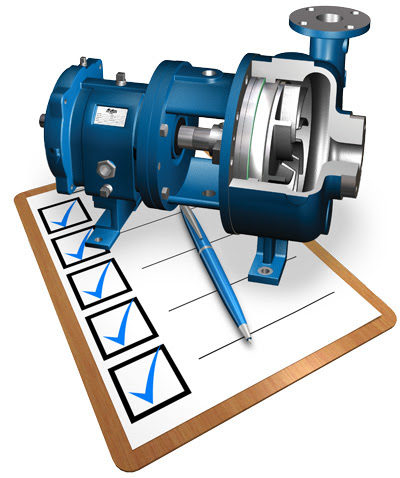
If the customer requires pump performance testing, the specific pump test and consequently the acceptable tolerances must be defined. The industry standard specification for our pumps is ANSI/Hydraulic institute 14.6-2011. But note, even within that 75 page specification there are numerous variables, detailed options and tolerance classes that remain to be defined.
The time to have the test, the delivery schedule and the subsequent costs defined is before the order is placed.
-Jim Elsey
Featured, Resources, Summit Pumps
I repeat this message annually… no, monthly. No matter the manufacturer; the majority of all pumps do NOT come from the factory ready to start up.
The pump will require oil to be added to the bearing housings.
The impeller clearance must be determined and set for the fluid temperature. The direction of rotation should be ascertained and matched to the phase rotation on the motor driver (you must do this step with the coupling removed).

The driver will need to be aligned to the pump. When I tell people that they should align their pump nine times, I get some funny looks, but allow me to explain. Yes, the alignment may have been performed in the factory, but the very second the unit was moved for transport the alignment was lost. You will need to recheck the alignment when the unit is installed and leveled, again when the base is grouted, again after the piping is installed and again after the pump has been running up to temp.
The mechanical seal will need to be set after the above steps are completed.
Finally… please understand that most manufacturers do not install the coupling at the factory because it will just need to be removed for all the above reasons.
Be ready to complete these items, so you look like a pump professional.
-Jim Elsey
Featured, Resources, Summit Pumps
Pressure and temperature boundaries are the most common violations we see in this boundary category. Don’t forget that pump suction pressure is part of the overall discharge pressure calculation.

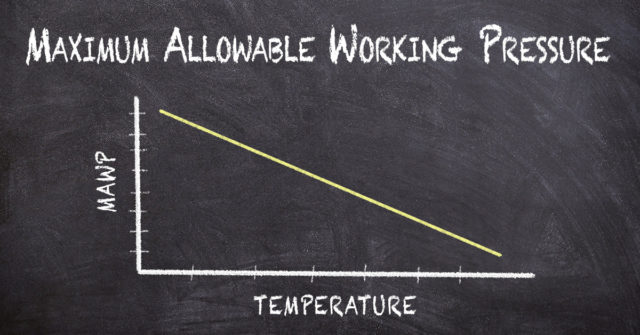
Note: Allowable pressure limits decrease with increasing temperature and not all materials have the same ratings.
If there is any doubt please consult with us. We can send you a rating chart for both 150 and 300 class flange ratings.
Do not get a ticket from the boundary police.
-Jim Elsey
Featured, Resources, Summit Pumps
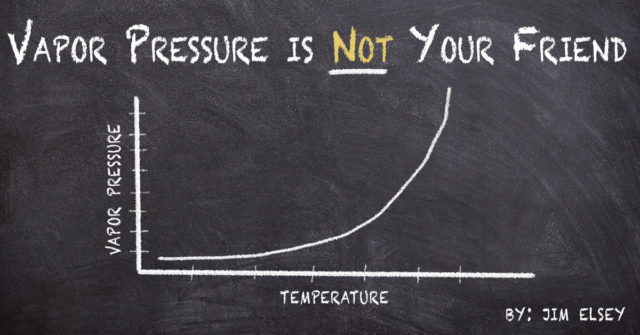
Be very careful on self-primer lift applications because the liquid temperature
directly affects its vapor pressure and that…
…changes the Net Positive Suction Head Available (NPSHA).
 Example: Self-Primer – two temperatures… two outcomes:
Example: Self-Primer – two temperatures… two outcomes:
For the example we will use two versions of the otherwise same application. The applications are identical in both versions except the temperature of the fluid is higher in the second version. The higher temperature signifies the vapor pressure has increased.
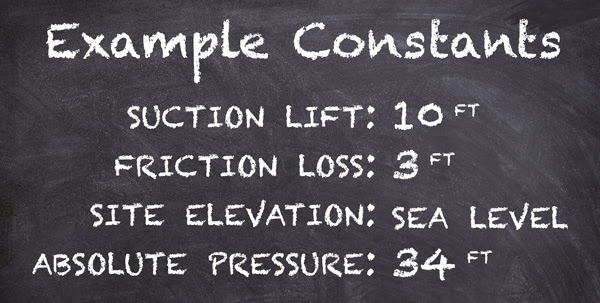
*Note: 14.7 PSI absolute atmospheric pressure x 2.31 divided by the Specific Gravity of 1 = 33.96 feet ≈ 34).
Any increase in elevation will reduce your absolute pressure (head) and consequently the NPSHA.
In Example A the fluid is water at 68ºF.
In Example B the fluid is water at 150ºF.
As you look up the vapor pressure of water for each temperature note it is normally expressed in PSIA (pounds per square inch absolute) and so you need to convert that value to feet (head) then you will have the component value in the proper units needed to do the NPSHA calculation. Remember that to convert PSI (or PSIA) to head, you must multiply by 2.31 and divide by the specific gravity.
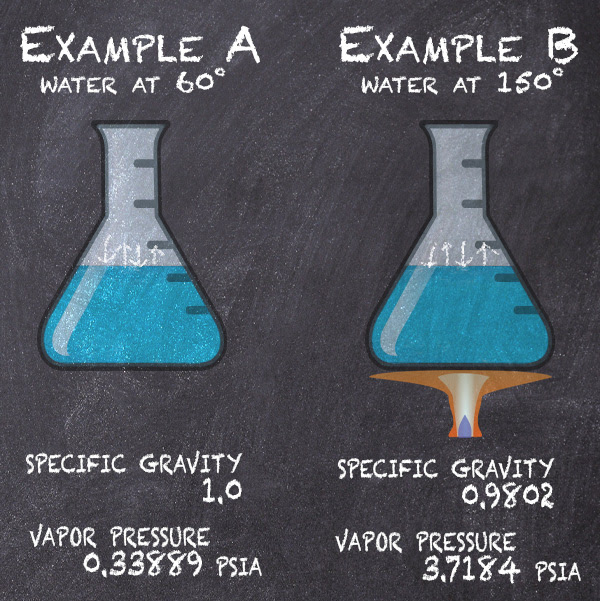
You can find these vapor pressure and specific gravity values in several places;
I use the Cameron Hydraulic Data Book or Cranes Technical Publication 410
(There are also several reputable web based sources).
Once you have the conversions then fill in the values for the formula and do the simple math steps (0.33889 X 2.31 = 0.783 ft. and 0.783 divided by 1 is 0.783). Then fill in the values in the NPSHA formula and complete the steps for the answer. Repeat these steps using the different values for Example B.

Note: The difference between the two versions for the value of NPSHA = 7.98 feet which is approximately 8 feet.
Summary: With all the parameters except temperature (vapor pressure) the same and simply changing the temperature of the fluid from 68 to 150 degrees we reduced the NPSHA by 8 feet. This may not seem like a big deal until you realize that the pump requires 13 feet of NPSHR at the condition point and now 12.24 feet is all that is available. The pump will not operate correctly and will be in a constant state of cavitation.
Corollary: Most pump manufacturers do not recommend using self–primer pumps on lift applications above 145°F for this reason. The solution for fluid temperatures above 145ºF will likely involve a vertical sump pump or a submersible pump.
-Jim Elsey
Featured, Resources, Summit Pumps

For those of us living in the northern hemisphere winter is coming and this message will serve both as a reminder and a warning as to the inevitable arrival of temperatures below freezing.
For folks like us who reside in the higher latitudes, we know from experience that at some point in time (someday soon) the temperatures will fall below freezing. Before the freezing temperatures arrive we need to take action regarding those things that could be damaged in the freezing process. Simple things like the garden hose, the swimming pool, a boat or camper, and the forgotten items in the unheated garage/shed; like a pressure washer for example.
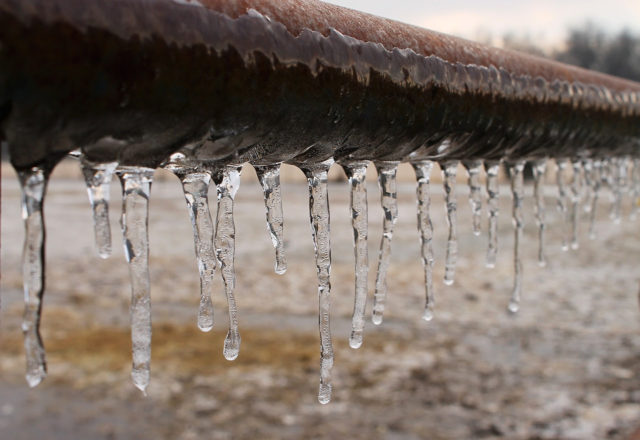
If you or your customers have a pump (and piping) that is not protected from freezing, you need to remove the water or the casing will crack and suffer expensive and permanent damage in the process. If you can’t remove the water then take steps to move the item to a protected area, add some type of anti-freeze, or add heat trace/tape.
 If you live in a more moderate climate, at lower latitudes, where it doesn’t freeze very often you may not think about these things or take any precautions. And this is also the same geographical area where we sell a lot of replacement casings when it does freeze. For some reason self-primer pumps are overlooked more often than other types. I guess because folks forget about the water in the priming chamber.
If you live in a more moderate climate, at lower latitudes, where it doesn’t freeze very often you may not think about these things or take any precautions. And this is also the same geographical area where we sell a lot of replacement casings when it does freeze. For some reason self-primer pumps are overlooked more often than other types. I guess because folks forget about the water in the priming chamber.
Did you know that water is one of the only liquids that expands when it freezes? A few solid elements expand when they freeze, but water is the essentially the only liquid that expands due to its crystalline structure. When liquid water is cooled down from standard temperatures, it contracts as you would expect until around 37 degrees F, but then as the temperature lowers below 37 degrees the water expands slightly until it reaches the freezing point. When water freezes it expands by about 9%.
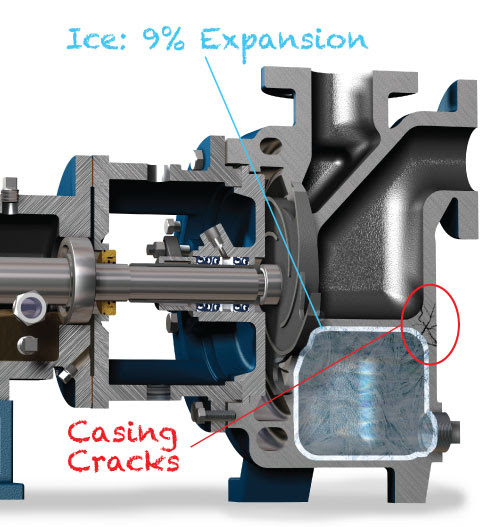
Winter is coming and the nights are long and cold. Will your pumps be ready?
-Jim Elsey
Featured, Resources, Summit Pumps

Open or Closed Tanks and the Effect on NPSHA Calculations
When working through NPSHA calculations for pump applications we need to know if the suction supply tank is open to the atmosphere or not. If it is an open tank the calculation is easy; as we just convert the ambient pressure to head for the first factor in the NPSHA calculation. Don’t forget to convert to absolute values and compensate atmospheric pressure for the local altitude above sea level. If the tank is closed, then we need to do a little more work converting the pressure or vacuum to absolute head for the calculation.
The Issue:
Often the customer will tell us the tank is closed to atmosphere, but it really isn’t; consequently the NPSHA calculations will be incorrect. The resulting NPSHA error will lead to a noncompetitive pump selection.
Sometimes the suction supply tank appears to be closed to atmospheric pressure, but if you look closer at the tank you will see it has breather valves installed. If there is a breather valve installed the tank pressure will always be very close to atmospheric pressure. It is very common, especially in the oil and gas world and also in the chemical and petro-chem arenas to use breather valves on the big bulk tanks. You may actually witness these breather valves on any size tank because the owner needs to protect the investment. Please realize these scenarios may also include rail tank cars, but do not confuse these examples with tank cars that are specifically designed to be pressurized or placed under vacuum for unloading purposes.
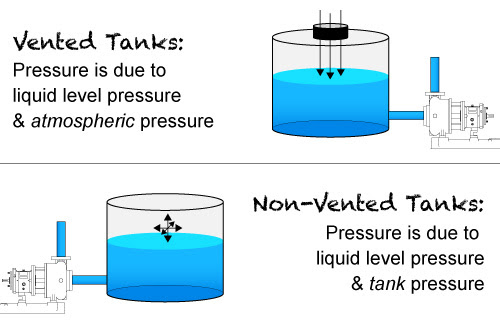
The Breather Valves Protect the Supply Tanks from:
- Overpressure (rupture) and or vacuum (implosion) issues
- Fire protection
- Evaporation; loss of product
- Corrosion protection
Another purpose is to prevent excess air and or water (plus other bad stuff like general pollution, O3 and NOx) from destroying the product integrity while it is in the tank. The purpose is to protect the product from outside influence and or to protect the outside environment from the product.
These protection/breather valves are normally required by EPA and or OSHA …they are not just a good idea, they are often a legal requirement in many product applications. Most tank owners apply the same rules to all of their tanks regardless of the product, tank size or location. Note that both the EPA and OSHA will defer to API 2000 for the selection and sizing criteria for the breather valves.
So…I Just Want to do the NPSHA Calculation, What Now?
If the tank has a breather valve, the answer is to simply use the local atmospheric pressure for the NPSHA calculations, because the actual tank pressure is going to be very close.

What if There is no Breather Valve and the Tank is Really Closed Off to Atmosphere?:
When you have a closed tank; I recommend you read my two Pumps and Systems articles on this subject from October and November of 2018, where the basics are covered.
https://www.pumpsandsystems.com/how-calculate-npsha-systems-under-vacuum
https://www.pumpsandsystems.com/calculate-npsha-closed-pressurized-system
If after reading you are still in doubt, call your RSM or engineering for assistance.
Last Comment:
Given a pump system with a supply tank open to atmosphere: note that on the suction line to an operating pump it is not uncommon to have a pressure lower than ambient. You may only expect this situation on a pump that is involved in a suction lift, but even for a flooded suction condition the suction pressure at the pump inlet can be at a vacuum. You can accurately calculate the actual pressure (vacuum) anywhere along the line by using Bernoulli’s Equation. Open and shut case… Easy peasy – lemon squeezy.
References:
OSHA 1910.106 July 1985
API 2000 Venting for Tanks 7th Edition 2014
API 12 (49 CFR 195.264)(b)(1) Specification for tanks
API 650 (CFR 132(b)(3) Specifications for large welded tanks
API Bulletin 2521 (Evaporation Reduction)
API Bulletin 2513 (Evaporation Losses)
EPA 40 CFR 112. Note: This regulation does not actually use the terms “aboveground storage tank.” Instead the term “bulk storage container”.
DOT (various/numerous with respect to rail cars)
-Jim Elsey

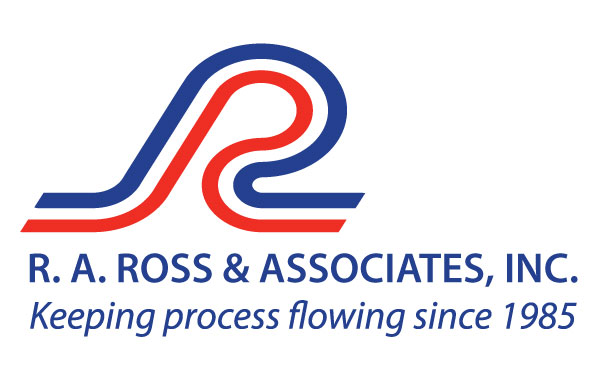








 If you live in a more moderate climate, at lower latitudes, where it doesn’t freeze very often you may not think about these things or take any precautions. And this is also the same geographical area where we sell a lot of replacement casings when it does freeze. For some reason self-primer pumps are overlooked more often than other types. I guess because folks forget about the water in the priming chamber.
If you live in a more moderate climate, at lower latitudes, where it doesn’t freeze very often you may not think about these things or take any precautions. And this is also the same geographical area where we sell a lot of replacement casings when it does freeze. For some reason self-primer pumps are overlooked more often than other types. I guess because folks forget about the water in the priming chamber.


